Estimating PV Module Performance over Large Geographical Regions: The Role of Irradiance, Air Temperature, Wind Speed and Solar Spectrum
Abstract
:1. Introduction
- Some PV module types show variations in module efficiency that are caused by long-term exposure to sunlight and/or high temperatures.
2. Input Data Sets
2.1. Solar Radiation Data
2.2. Ambient Temperature and Wind Speed Data
3. Mathematical Models for PV Performance
3.1. Inclined-Plane Irradiance
3.2. Angle-of-Incidence (AOI) Effects
3.3. Spectral Effects
3.4. Module Temperature
3.5. PV Performance
3.6. Definition of the Module Performance Rati
3.7. Calculation over Large Geographical Areas
- Global inclined irradiance, G
- Global inclined irradiance corrected for AOI effects, Ga
- Spectrally resolved global inclined irradiance, corrected for AOI effects, Ra(λ)
- Module power output for a nominal PV power PSTC = 1 kWp, taking into account AOI, the effects of temperature and low irradiance, but ignoring the effect of wind (essentially setting U1 = 0 in Equation (3)
- Module power output Pw, also taking into account wind speed.
4. Results and Discussion
4.1. Comparison of PV Module Performance Using Measured and Satellite Retrieved Irradiance Data
- Global horizontal and direct horizontal irradiance values (GHI and DHI, respectively)
- Ambient temperature (Tamb)
- Measured–Single location: considering the data from the measured data set (measured irradiance and temperature values) and applying the interpolation method.
- Satellite–Single location: considering the data from the satellite data set (satellite retrieved irradiance values and ambient temperature from ECMWF ERA-interim reanalysis) and applying the interpolation method.
- Satellite–Equation: considering the data from the satellite data set together with temperature data from the ECMWF operational forecast and applying directly Equation (4).
4.2. Calculations of PV Performance over Eurasia and Africa
- North: 60° N
- South: 40° S
- West: 25° W
- East: 115° E
4.3. The Effect of Module Inclination on Module Performance Ratio
4.4. Interannual Variation in MPR
4.5. Influence of Module Type
4.6. Effect of Spectral Variation on the Energy Output of Different Module Types
4.7. Combining All Models
5. Conclusions and Further Work
- PV module reflectivity at shallow angles of incidence (angle-of-incidence effect)
- Effects of variation in the solar spectrum
- Dependence of module efficiency on in-plane irradiance and module temperature
- Effects of irradiance, air temperature and wind speed on the module temperature
- Some new PV module types have special coatings or textured surfaces to reduce the losses due to reflectivity. Measured data from such modules could be used to quantify the improvement in overall PV energy output.
- The method for estimating the spectral effects has so far only considered single-junction PV technologies. Tandem cells and multijunction technologies will require modifications to the methods used here.
- Some PV technologies show long-term variation in the module efficiency. This is especially the case for amorphous silicon technologies. This will require development of models for the behaviour of these modules.
- PV module performance tends to degrade with age, in a way that almost certainly depends on the environmental conditions. Better models for this effect will have to be developed before it is possible to estimate the geographical variation of age-related degradation.
Nomenclature
| Acronyms | |
|---|---|
| AOI | Angle of Incidence |
| BSRN | Baseline Surface Radiation Network |
| MPP | Maximum Power Point |
| STC | Standard Test Conditions |
| ECMWF | European Centre for Medium-Range Weather Forecast |
| Symbols | |
|---|---|
| dane (m) | Height above ground of the anemometer measuring wind speed |
| dmod (m) | Height above ground of the PV module |
| Etot (Wh) | Total energy produced by the module |
| Eyear (Wh) | Total yearly energy produced by the module |
| ⟨ηyear⟩(−) | Annual average module efficiency |
| ηSTC (−) | Module efficiency at STC |
| GSTC = 1000W · m−2 | In-plane irradiance at STC conditions |
| GHI (W · m−2) | Global horizontal irradiance |
| DHI (W · m−2) | Direct horizontal irradiance |
| G (W · m−2) | In-plane global irradiance |
| Ga (W · m−2) | In-plane global irradiance corrected for AOI effects |
| Gef f (W · m−2) | In-plane effective global irradiance considering the spectral effects |
| H,Ha (kWh · m−2) | In-plane global irradiation over a time period, without and with AOI effects respectively |
| Hyear (kWh · m−2) | Total yearly in-plane irradiation |
| R(λ) (W · m−2 · nm−1) | Spectral irradiance at wavelength λ |
| RSTC (λ) (W · m−2 · nm−1) | Spectral irradiance at STC at wavelength λ |
| Ra(λ) (W · m−2 · nm−1) | Spectral global inclined irradiance corrected for AOI effects |
| Sr(λ) (AW−1) | Spectral response of the PV module at wavelength λ |
| MPR (−) | Module Performance Ratio |
| MPRyear (−) | Annual average Module Performance Ratio |
| MPRW,year (−) | Annual average Module Performance Ratio considering wind effects |
| Pw (W) | Estimated module power considering wind effects |
| PSTC (W) | Module power at STC |
| U0(W·°C−1·m−2) | Coefficient for module temperature model |
| U1(Ws°C−1·m−3) | Coefficient for module temperature model |
| k1 to k6 | Coefficients for the PV performance model |
| Tamb (°C) | Ambient (air) temperature |
| Tmod (°C) | Module temperature |
| Wane (ms−1) | Wind speed at the height of the anemometer |
| Wmod (ms−1) | Wind speed at the height of the PV module |
Acknowledgments
Author Contributions
Conflicts of Interest
References
- Martin, N.; Ruiz, J. Calculation of the PV modules angular losses under field conditions by means of an analytical model. Solar Energy Mater. Solar Cells 2001, 70, 25–38. [Google Scholar]
- Huld, T.; Šúri, M.; Dunlop, E. Comparison of potential solar electricity output from fixed-inclined and two-axis tracking photovoltaic modules in Europe. Prog. Photovolt. Res. Appl. 2008, 16, 47–59. [Google Scholar]
- Huld, T.; Gottschalg, R.; Beyer, H.; Topič, M. Mapping the performance of PV modules, effects of module type and data averaging. Solar Energy 2010, 84, 324–338. [Google Scholar]
- Gottschalg, R.; Infield, D.G.; Kearny, M.J. Experimental study of variations of the solar spectrum of relevance to thin film solar cells. Solar Energy Mater. Solar Cells 2003, 79, 527–537. [Google Scholar]
- Gottschalg, R.; Betts, T.R.; Williams, S.R.; Sauter, D.; Infield, D.G.; Kearny, M.J. A critical appraisal of the factors affecting energy production from amorphous silicon photovoltaic arrays in a maritime climate. Solar Energy 2004, 77, 909–916. [Google Scholar]
- Minemoto, T.; Nagae, S.; Takakura, H. Impact of spectral irradiance distribution and temperature on the outdoor performance of amorphous Si photovoltaic modules. Solar Energy Mater. Solar Cells 2007, 91, 919–923. [Google Scholar]
- Cornaro, C.; Andreotti, A. Influence of average photon energy index on solar irradiance characteristics and outdoor performance of photovoltaic modules. Progress Photovolt. Res. Appl. 2013, 21, 996–1003. [Google Scholar]
- Ye, J.Y.; Reindl, T.; Aberle, A.G.; Walsh, T.M. Effect of solar spectrum on the performance of various thin-film PV module technologies in tropical Singapore. IEEE J. Photovolt. 2014, 4, 1268–1274. [Google Scholar]
- Alonso-Abella, M.; Chenlo, F.; Nofuentes, G.; Torres-Ramirez, M. Analysis of spectral effects on the energy yield of different PV (photovoltaic) technologies: The case of four specific sites. Energy 2014, 67, 435–443. [Google Scholar]
- Dirnberger, D.; Blackburn, G.; Müller, B.; Reise, C. On the impact of solar spectral irradiance on the yield of different PV technologies. Solar Energy Mater. Solar Cells 2015, 132, 431–442. [Google Scholar]
- Gracia Amillo, A.; Huld, T.; Vourlioti, P.; Müller, R.; Norton, M. Application of satellite-based spectrally resolved solar radiation data to PV performance studies. Energies 2015, 8, 3455–3488. [Google Scholar]
- Skoplaki, E.; Palyvos, J. On the temperature dependence of photovoltaic module electrical performance: A review of efficiency/power correlations. Solar Energy Mater. Solar Cells 2009, 83, 614–624. [Google Scholar]
- Faiman, D. Assessing the outdoor operating temperature of photovoltaic modules. Prog. Photovolt. Res. Appl. 2008, 16, 307–315. [Google Scholar]
- Koehl, M.; Heck, M.; Wiesmeier, S.; Wirth, J. Modeling of the nominal operating cell temperature based on outdoor weathering. Solar Energy Mater. Solar Cells 2011, 95, 1638–1646. [Google Scholar]
- King, D.; Boyson, W.; Kratochvil, J. Photovoltaic Array Performance Model; Technical Report SAND2004-3535; Sandia National Laboratories: Albuquerque, NM, USA, 2004. [Google Scholar]
- Dittmann, S.; Friesen, G.; Williams, S.; Betts, T.; Gottschalg, R.; Beyer, H.; Guérin de Montgareuil, A.; van der Borg, N.; Burgers, A.; Huld, T.; et al. Results of the 3rd modeling round robin within the European project PERFORMANCE—Comparison of module energy rating methods, Proceedings of the 25th European Photovoltaic Solar Energy Conference, Valencia, Spain, 6–10 September 2010; pp. 4333–4338.
- Huld, T.A.; Friesen, G.; Skoczek, A.; Kenny, R.A.; Sample, T.; Field, M.; Dunlop, E.D. A power-rating model for crystalline silicon PV modules. Solar Energy Mater. Solar Cells 2011, 95, 3359–3369. [Google Scholar]
- IEC Central Office. Photovoltaic Devices—Part 3: Measurement Principles for Terrestrial Photovoltaic (PV) Solar Devices with Reference Spectral Irradiance Data; Technical Report IEC 61215-3; International Electrotechnical Commission: Geneva, Switzerland, 2005. [Google Scholar]
- Bücher, K. Site dependence of the energy collection of PV modules. Solar Energy Mater. Solar Cells 1997, 47, 85–94. [Google Scholar]
- Agugiaro, G.; Nex, F.; Remondino, F.; de Filippi, R.; Droghetti, S.; Furlanello, C. Solar radiation estimation on building roofs and web-based solar cadastre, Proceedings of the ISPRS Annals of the Photogrammetry, Remote Sensing and Spatial Information Sciences, Melbourne, Australia, 25 August–1 September 2012; pp. 177–182.
- Ramirez Camargo, L.; Zink, R.; Dorner, W.; Stoeglehner, G. Spatio-temporal modeling of roof-top photovoltaic panels for improved technical potential assessment and electricity peak load offsetting at the municipal scale. Comput. Environ. Urban Syst. 2015, 52, 58–69. [Google Scholar]
- Nguyen, H.; Pearce, J. Estimating potential photovoltaic yield with r.sun and the open source Geographical Resources Analysis Support System. Solar Energy 2010, 84, 831–843. [Google Scholar]
- Huld, T.; Šúri, M.; Dunlop, E. Geographical variation of the conversion efficiency of crystalline silicon photovoltaic modules in Europe. Prog. Photovolt. Res. Appl. 2008, 16, 595–607. [Google Scholar]
- Müller, R.; Matsoukas, C.; Gratzki, A.; Behr, H.; Hollmann, R. The CM-SAF operational scheme for the satellite based retrieval of solar surface irradiance—A LUT based eigenvector hybrid approach. Remote Sens. Environ. 2009, 113, 1012–1024. [Google Scholar]
- Huld, T.; Müller, R.; Gambardella, A. A new solar radiation database for estimating PV performance in Europe and Africa. Solar Energy 2012, 86, 1803–1815. [Google Scholar]
- Müller, R.; Behrendt, T.; Hammer, A.; Kemper, A. A new algorithm for the satellite-based retrieval of solar surface irradiance in spectral bands. Remote Sens. 2012, 4, 622–647. [Google Scholar]
- Gracia Amillo, A.; Huld, T.; Müller, R. A new database of global and direct solar radiation using the eastern meteosat satellite, models and validation. Remote Sens. 2014, 6, 8165–8189. [Google Scholar]
- Muneer, T. Solar radiation model for Europe. Build. Serv. Eng. Res. Technol. 1990, 4, 153–163. [Google Scholar]
- Gracia Amillo, A.; Huld, T. Performance Comparison of Different Models for the Estimation of Global Irradiance on Inclined Surfaces; Technical Report; European Commission Joint Research Centre. Avaliable online: http://re.jrc.ec.europa.eu/pvgis/doc/report/ReqNO_JRC81902_Report.pdf accessed on 20 March 2015.
- IEC Central Office. Crystalline Silicon Terrestrial Photovoltaic (PV) Modules—Design Qualification and Type Approval; Technical Report IEC-60904-3; International Electrotechnical Commission: Geneva, Switzerland, 2008. [Google Scholar]
- Bahrs, U.; Zaaiman, W.; Mertens, M.; Ossenbrink, H. Automatic large area spectral response facility, Proceedings of the 14th European Photovoltaic Solar Energy Conference, Barcelona, Spain, 30 June–4 July 1997; pp. 2296–2298.
- Nikolaeva-Dimitrova, M.; Kenny, R.; Dunlop, E.; Pravettoni, M. Seasonal variations on energy yield of a-Si, hybrid, and crystalline Si PV modules. Prog. Photovolt. Res. Appl. 2010, 14, 311–320. [Google Scholar]
- Piliougine, M.; Elizondo, D.; Mora-López, L.; Sidrach-de Cardone, M. Multilayer perceptron applied to the estimation of the influence of the solar spectral distribution on thin-film photovoltaic modules. Applied Energy 2013, 112, 610–617. [Google Scholar]
- Huld, T.; Gracia Amillo, A.M. Supplementary material for the present paper. Availiable online: http://re.jrc.ec.europa.eu/pvgis/papers_supplementary/performance_mapping/index.html accessed on 20 May 2015.
- Huld, T.; Pinedo Pascua, I. Spatial downscaling of 2-meter air temperature using operational forecast data. Energies 2015, 8, 2381–2411. [Google Scholar]
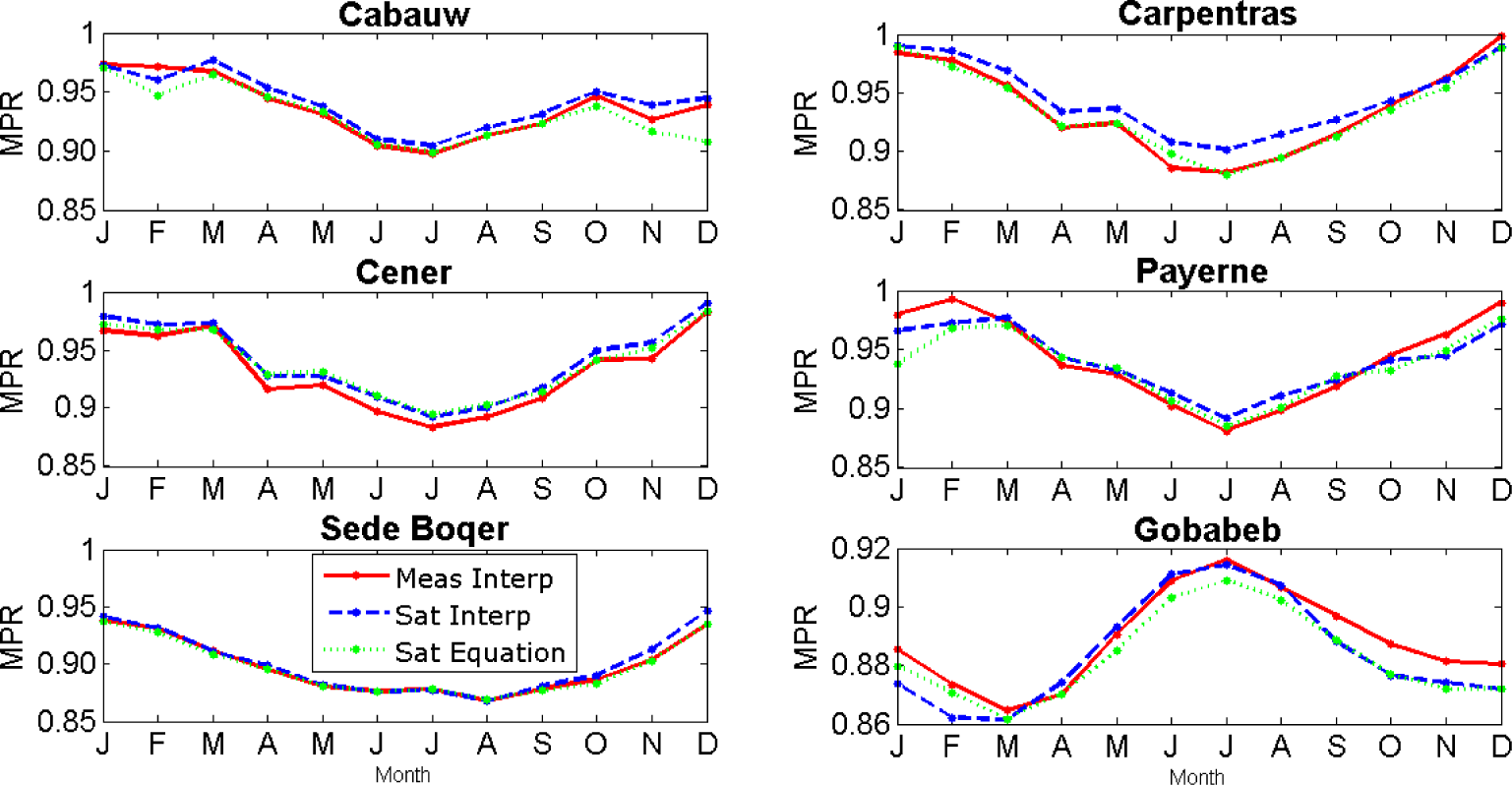
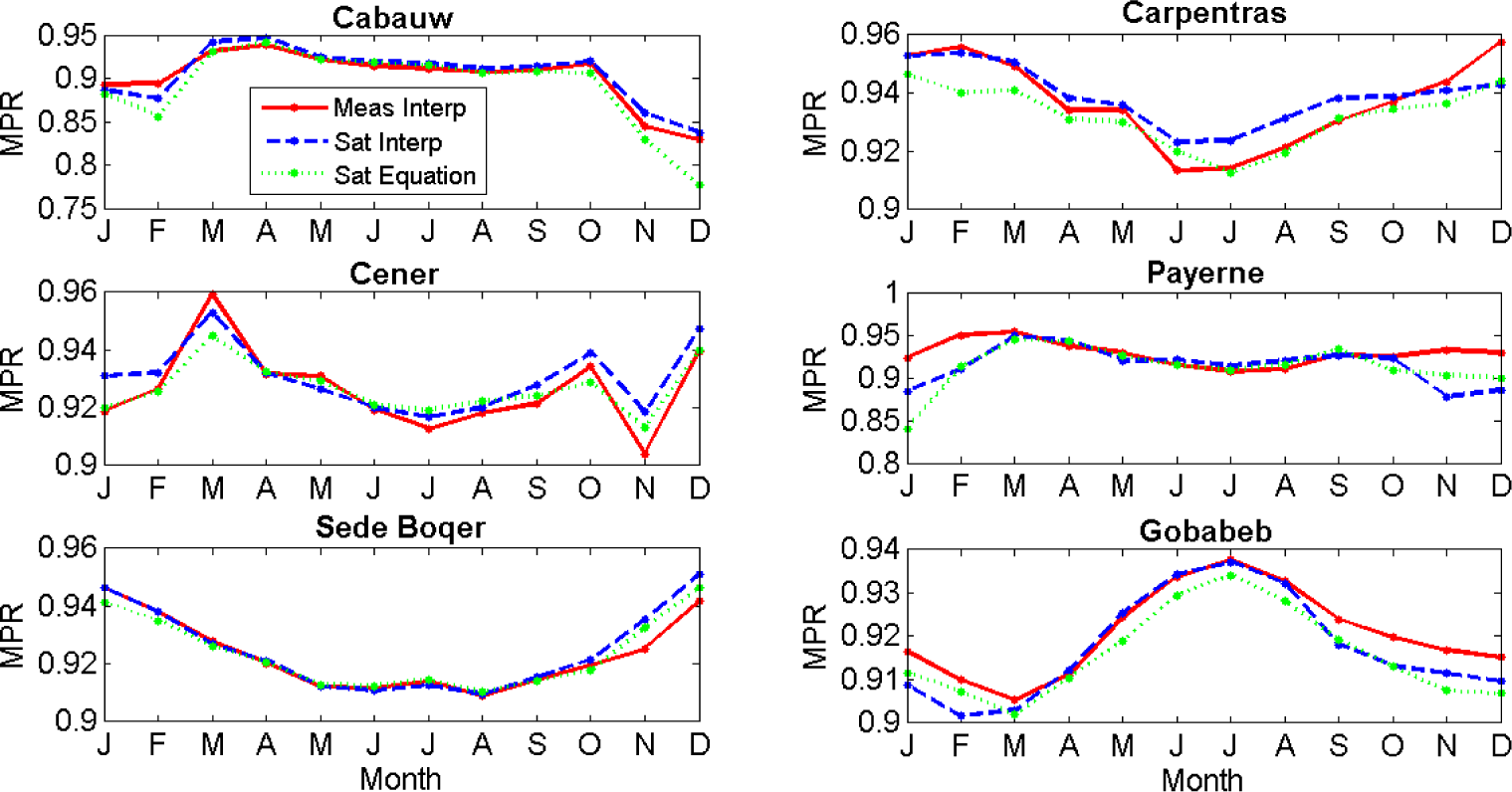

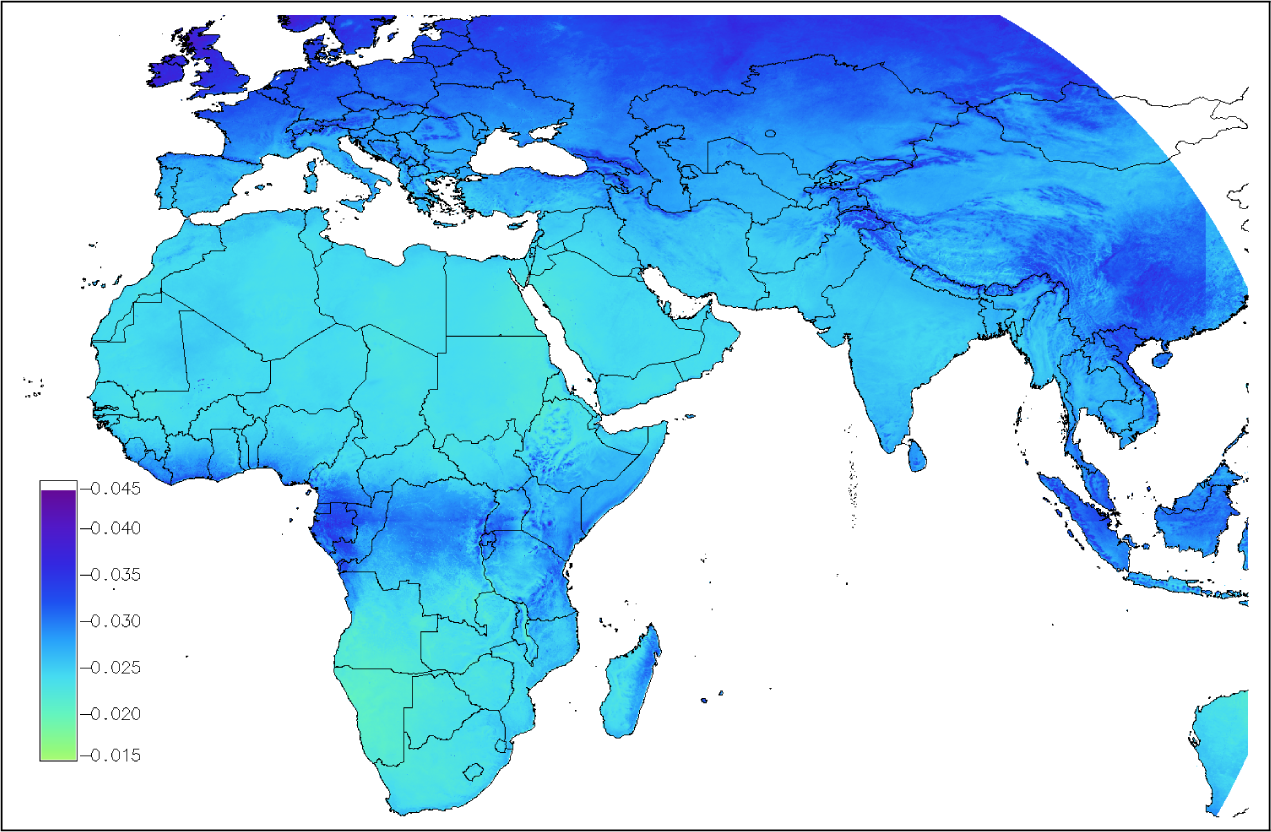

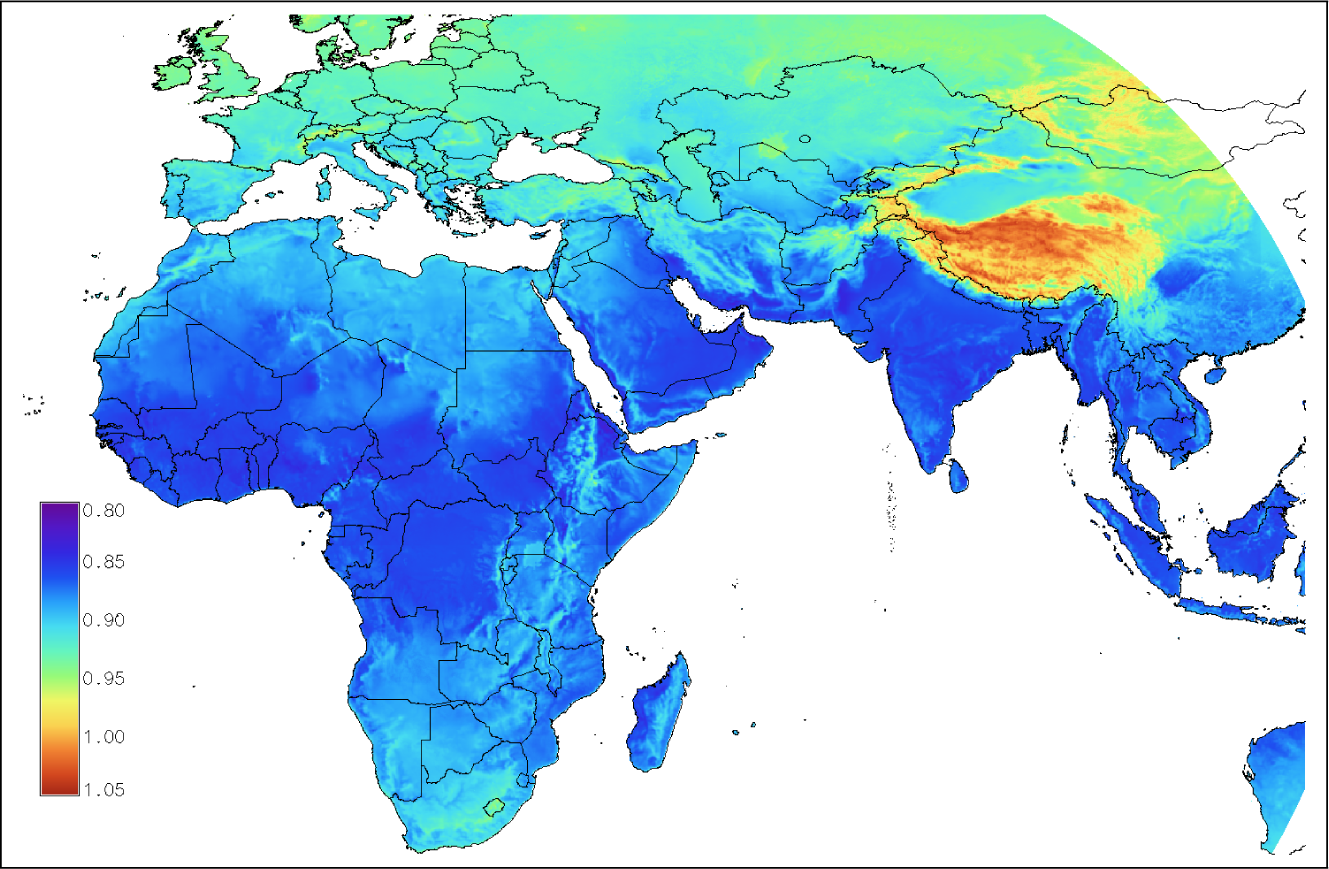

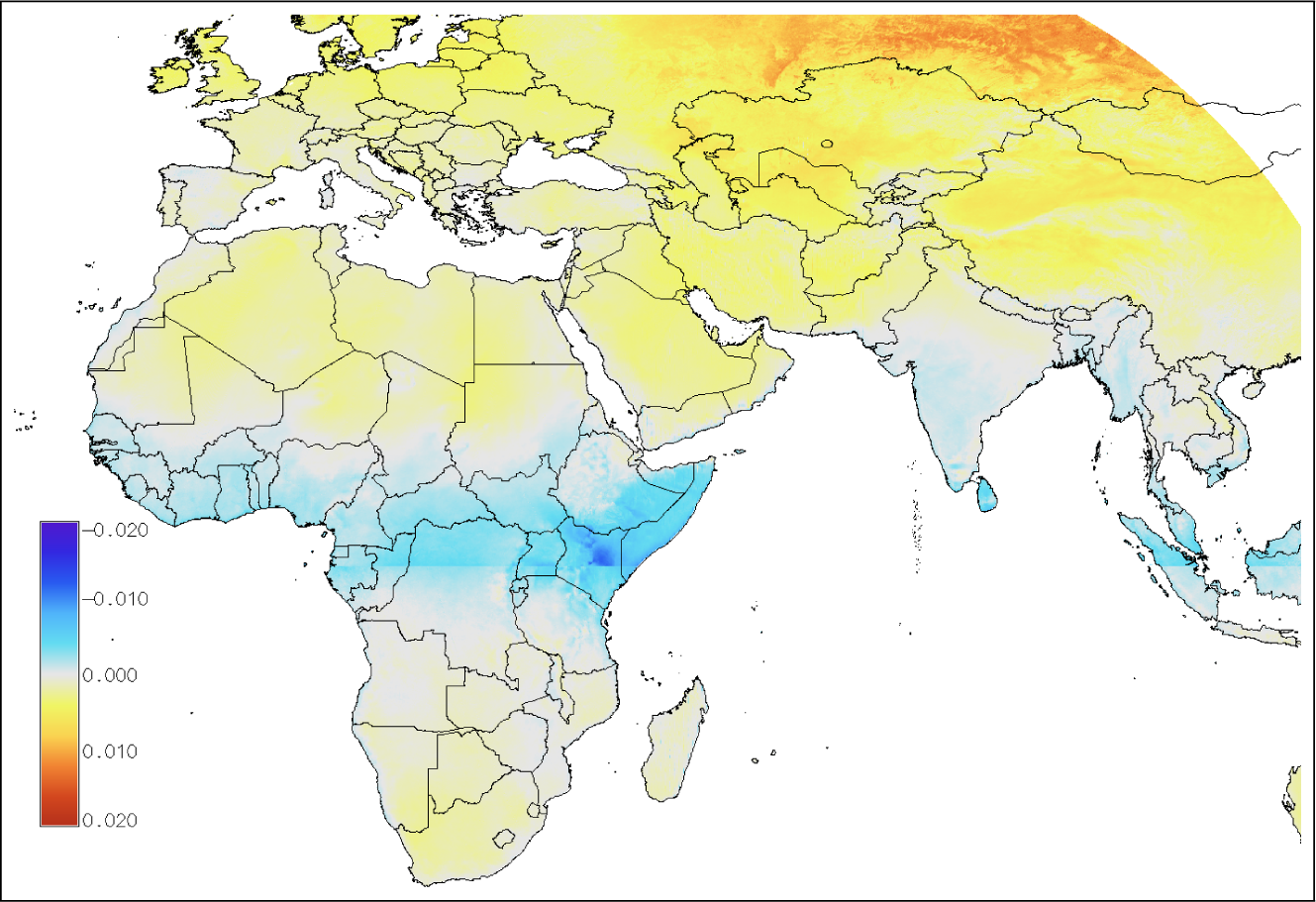
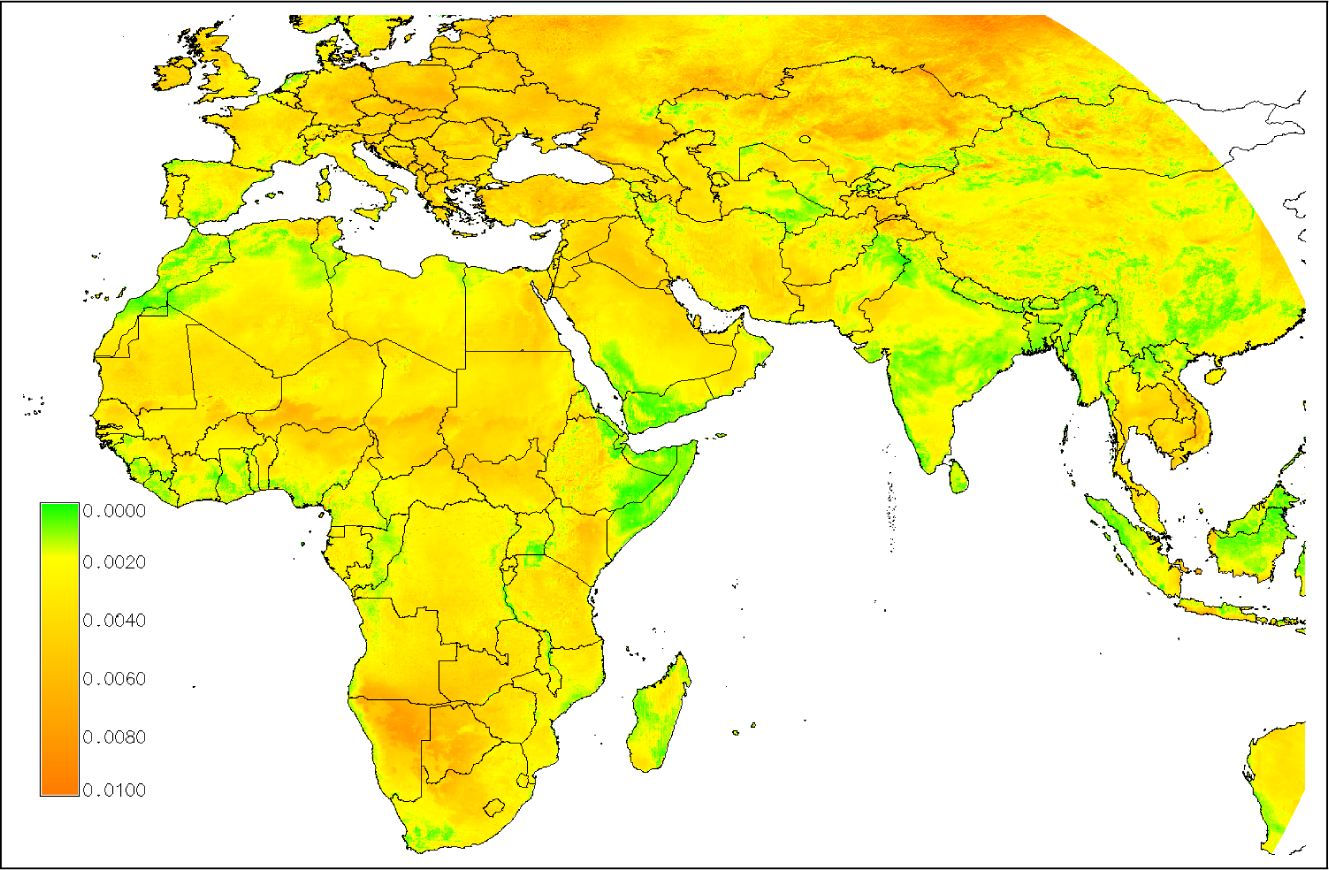

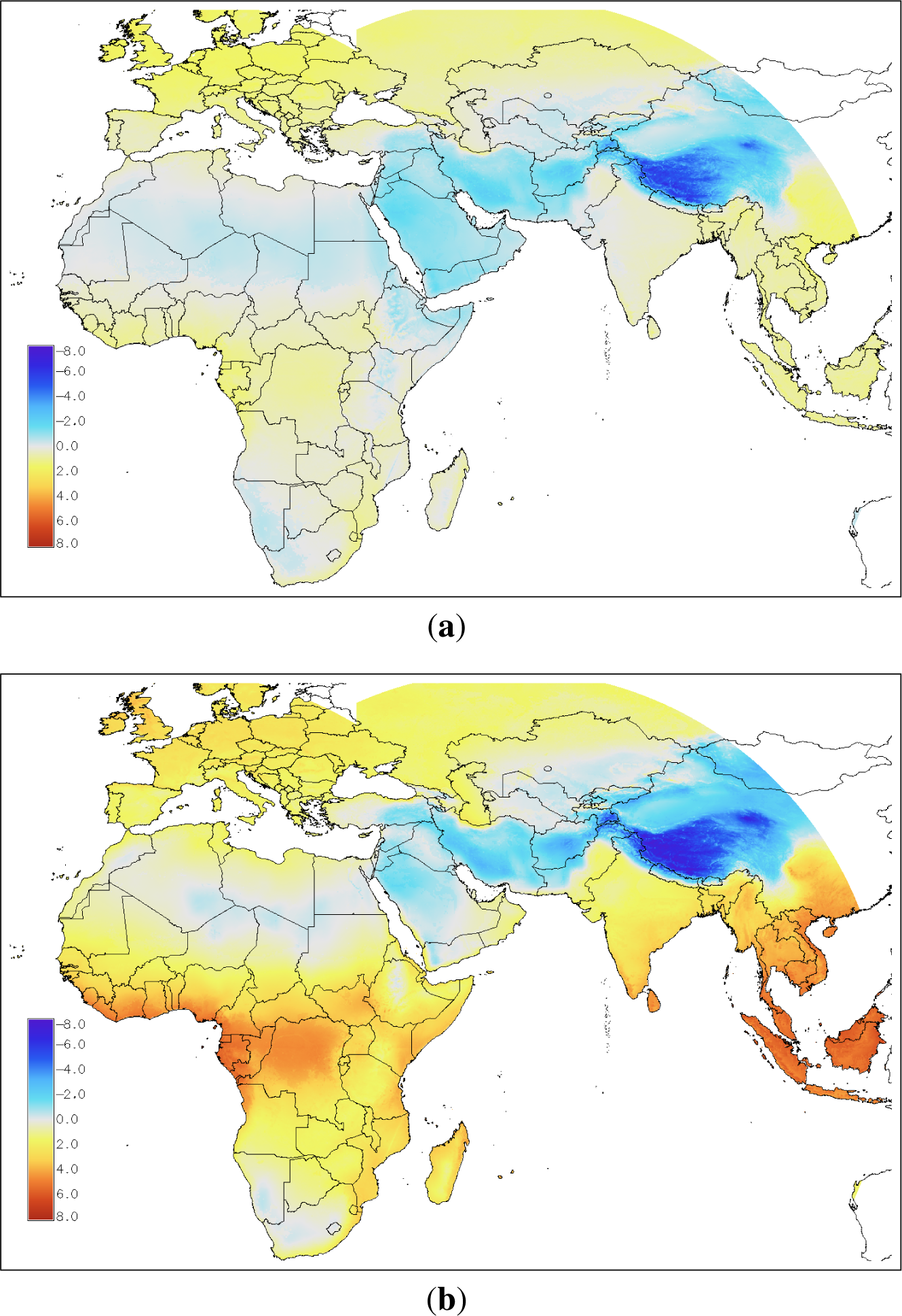
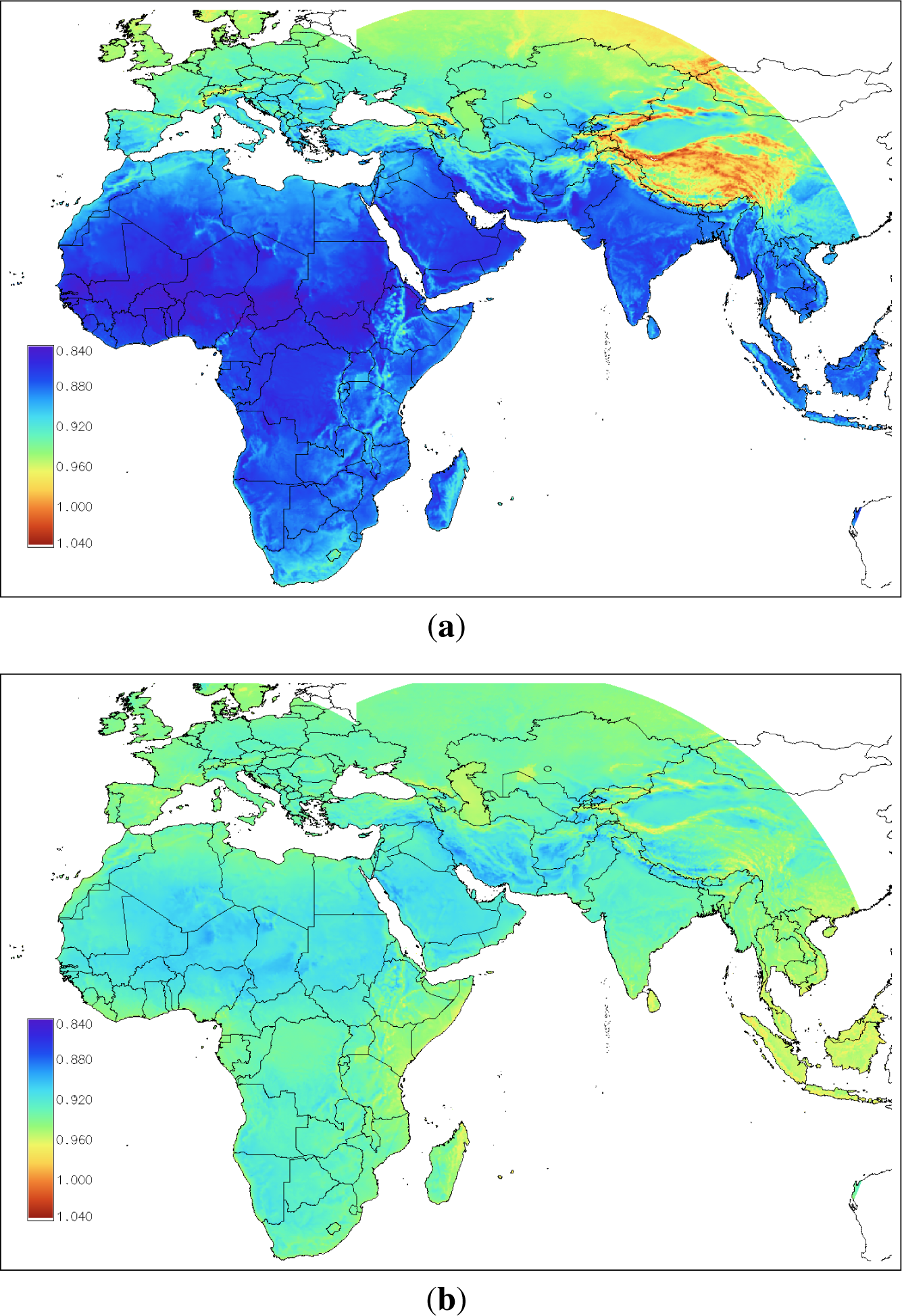
| Module Type | U0 | U1 |
|---|---|---|
| c-Si | 26.9 | 6.20 |
| CdTe | 23.4 | 5.44 |
| Module Type | c-Si | CdTe |
|---|---|---|
| k1 | −0.017237 | −0.046689 |
| k2 | −0.040465 | −0.072844 |
| k3 | −0.004702 | −0.002262 |
| k4 | 0.000149 | 0.000276 |
| k5 | 0.000170 | 0.000159 |
| k6 | 0.000005 | −0.000006 |
| Location | Coordinates | Year |
|---|---|---|
| Cabauw (The Netherlands) | 51.97° N, 4.93° E | 2010 |
| Carpentras (France) | 44.08° N, 5.05° E | 2010 |
| Cener (Spain) | 42.82° N, 1.60° W | 2010 |
| Payerne (Switzerland) | 46.82° N, 6.95° E | 2010 |
| Sede Boqer (Israel) | 30.87° N, 34.78° E | 2010 |
| Gobabeb (Namibia) | 23.57° S, 15.01° E | 2013 |
| MPR Station | Crystalline silicon
| Cadmium Telluride
| ||||
|---|---|---|---|---|---|---|
| Measured Interpolation | Satellite Interpolation | Satellite Equation | Measured Interpolation | Satellite Interpolation | Satellite Equation | |
| Cabauw | 0.926 | 0.933 | 0.926 | 0.915 | 0.921 | 0.913 |
| Carpentras | 0.923 | 0.936 | 0.921 | 0.932 | 0.937 | 0.928 |
| Cener | 0.921 | 0.929 | 0.928 | 0.926 | 0.929 | 0.927 |
| Payerne | 0.925 | 0.930 | 0.927 | 0.925 | 0.923 | 0.920 |
| Sede Boqer | 0.895 | 0.897 | 0.893 | 0.921 | 0.923 | 0.921 |
| Gobabeb | 0.888 | 0.883 | 0.882 | 0.920 | 0.917 | 0.915 |
© 2015 by the authors; licensee MDPI, Basel, Switzerland This article is an open access article distributed under the terms and conditions of the Creative Commons Attribution license (http://creativecommons.org/licenses/by/4.0/).
Share and Cite
Huld, T.; Amillo, A.M.G. Estimating PV Module Performance over Large Geographical Regions: The Role of Irradiance, Air Temperature, Wind Speed and Solar Spectrum. Energies 2015, 8, 5159-5181. https://doi.org/10.3390/en8065159
Huld T, Amillo AMG. Estimating PV Module Performance over Large Geographical Regions: The Role of Irradiance, Air Temperature, Wind Speed and Solar Spectrum. Energies. 2015; 8(6):5159-5181. https://doi.org/10.3390/en8065159
Chicago/Turabian StyleHuld, Thomas, and Ana M. Gracia Amillo. 2015. "Estimating PV Module Performance over Large Geographical Regions: The Role of Irradiance, Air Temperature, Wind Speed and Solar Spectrum" Energies 8, no. 6: 5159-5181. https://doi.org/10.3390/en8065159





